College Hill, Providence, Rhode Island
College Hill is a neighborhood in Providence, Rhode Island, and one of six neighborhoods comprising the East Side of Providence and part of the College Hill Historic District. It is roughly bounded by South and North Main Street to the west, Power Street to the south, Governor Street and Arlington Avenue to the east and Olney Street to the north. College Hill is also home to Thayer Street, a shopping strip frequented by students in the Providence area.
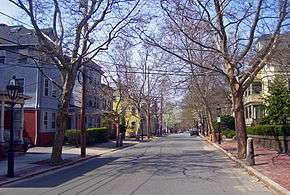
College Hill is the most affluent neighborhood in Providence, with a median family income of nearly three times that of the city as a whole.
College Hill has been designated as one of the Great Places in America[1] by the American Planning Association in 2011. College Hill became an example of Historic Preservation planning in 1959.

Etymology
The name refers to various major educational institutions established in the neighborhood: Brown University and Rhode Island School of Design, Pembroke College and the now relocated Bryant University. Prior to their development, the area was known as Prospect Hill.
History
The region was familiar to the local Wampanoag people when it was suggested that a refugee group recently expelled from the Plymouth Colony should settle upon a small hill on the right bank of the Seekonk River. Led by Roger Williams, after his 3-month winter encampment with Massasoit before escaping from Boston in Dec 1635, he and a small group of families bounded together by religious faith arrived on the west side of the hill. After friendly agreement with chief sachems of the Narragansett Canonicus and Miantonomi, and with providence aforethought, Williams and his group set camp.
By 1644, Williams along with Chad Brown and the ancient settlement of Providence had taken root at College Hill.

By the time of the American Revolution, the foot of the hill was densely populated with wharves, warehouses, shops, public buildings, and residential houses. Benefit Street was home to several hotels, including the Golden Ball Inn which hosted such guests as George Washington. In 1770, the college that became Brown University was moved to the old Brown farm and over the next century would gradually expand. In the nineteenth century, precious metals and jewellery trading drove much business on North Main Street, and RISD was established in 1877. By the 1900s, Brown had begun expanding more aggressively, demolishing nearly 100 houses in the 1950s for a residential quadrangle area.
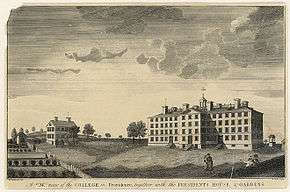
In the post-war years, Providence went into a decline. Many of the neighborhood's more historic centers were in disrepair and were slated for demolition as part of urban renewal projects. The Providence Preservation Society[2] intervened and the area is now home to one of the country's largest restored collections of 18th and 19th century Victorians and colonials.
Architectural history and preservation
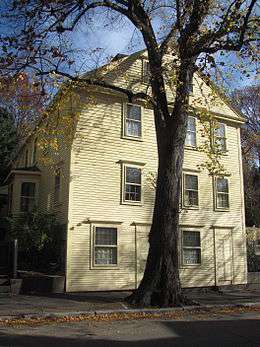

College Hill boasts architectural styles from the 18th century forward, including residences and institutional structures located along tree-lined streets with sidewalks. Some of the elegant homes include the Georgian-style John Brown House built in 1786 and the Renaissance Revival Governor Henry Lippitt House built in 1865. Both are National Historic Landmarks and museums. College Hill also has numerous churches built in the Baroque, Romanesque, Gothic, Greek Revival, and Renaissance architectural styles. The Fleur De Lys Studio is also part of the collection of historic buildings on College Hill. This cultural institution is inspired by the half-timbered stucco houses of Chester, England. The Providence Athenaeum built in 1838 is one of the nation’s oldest libraries and is an example of Greek-Revival architecture.[1]
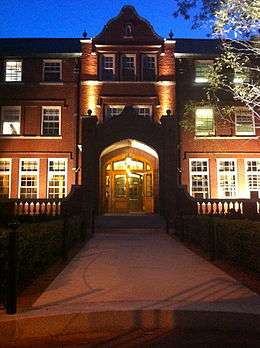
Benefit Street was formerly Back Street[4] in its colonial days. Coming into formation as a series of paths winding through backyards along the steep hillside, Back Street stretched across the land allotments of the original settlement parallel to the left bank Providence River, from Fox Point waterfront in the south to its terminus at North Main. As the area matured, the area was once home to both many wealthy business families in the 1700s, and black Americans in the 1900s.
Through the middle of the 20th century, the area nearer to the waterfront and Statehouse experienced a decline that remained until a 1970s rediscovery of historic structures along Benefit Street and on Aquidneck Island. These aged houses were occupied mostly by Providence's early minority population and were often subdivided into tenements. These units were often dilapidated and without adequate facilities and were targets for demolition under one of the city's proposed urban renewal projects.
In part, due to the Providence Preservation Society's efforts, plans were changed and the area became one of the first urban renewal projects in the US' modern Urban Planning history, to encompass rehabilitation of vital historic fabric as opposed to demolition and new construction. As so many other historic buildings were lost such as the Roger Mowry Tavern, many structures from around the Providence area were relocated to Benefit street. Today, they form one of the best examples of Colonial and Federal period Architecture on the Continent. Nearly all of the buildings situated near historic Benefit Street have been rehabilitated in some form. Preservation guidelines ensure that period specific new construction can be weaved into the existing collection of buildings. As the area is home to one of the finest cohesive collections of restored 18th- and 19th-century architecture in the United States[5] the College Hill neighborhood experiences significant infrastructure and building reinvestment dollars compared to other regions throughout the state.
Historic designation
An urban renewal and revitalization project was demonstrated by the Providence Preservation Society in 1959. The society's report, authored by preservationist Antoinette Downing and titled College Hill: A Demonstration Study of Historic Area Renewal, contained an inventory of properties and developed a historic area zoning ordinance and methods for integrating historic areas into future redevelopment. This report led to the neighborhood becoming a historic district and the project was noted as a national landmark and example for preservation as a means of community renewal. This preservation and reuse has allowed for the historic houses to become museums. Adaptive reuse has given new life to historic houses as museums. Sustainability is exemplified in the recently renovated Brown Street Park. The neighborhood is also connected to the downtown by the Riverwalk and many modes of transportation including bus, trolley, car, bike or walking.
Government
College Hill is divided along Angell Street between Ward One to the south and Ward Two to the north.[6][7]
As of the 2006 elections, Ward One is represented in the Providence City Council by Seth Yurdin and Ward Two by Cliff Wood. Both are Democrats. Major public buildings include the Providence County Courthouse and the Rhode Island Office of the Attorney General. Both are located on South Main Street, at the bottom of College Hill. The Rhode Island Supreme Court is located along Benefit Street.
Demographics
75.6% of College Hill residents are white while 13.6% are Asian, both well-above the city-wide averages of 54.5% and 6.2% respectively. African-Americans and Hispanics each comprise about 5% of the population.[8] A sizable portion of the population are seasonal students attending the local academic institutions and residing in collegiate housing or leases.
Median family income on College Hill is $121,521, well above the city-wide average. About 5% of households live below the poverty line. Fewer than 1% of households receive any public assistance.[8]
Universities and schools
College Hill is home to Brown University's main campus, and most of Rhode Island School of Design, whose buildings are adjacent to Brown, along the western slope of College Hill along South Main.
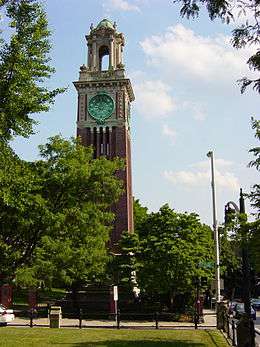
The Moses Brown School, on Lloyd Avenue (the summit of College Hill) and the Wheeler School, on Hope Street, are notable private schools in the neighborhood. Hope High School is located at the corner of Hope and Olney Streets, is one of Providence's major public high schools.[9]
Shopping and restaurants
Numerous cafes, restaurants, and shops are located along Thayer Street, adjoining Brown University at Soldier's Arch. Both streets are home to numerous small and independent shops, though Thayer Street has a few chain stores. Brown University's bookstore is located on Thayer.[10] Thayer Street's Avon Cinema, dating back to the early twentieth century, is a noted College Hill landmark.[11]
Parks
- Prospect Terrace Park is a park located on top of College Hill that allows for a scenic view of downtown Providence and the city and county beyond.
- Riverwalk, located along the Providence River, is where part of Waterfire is held.
- Roger Williams National Memorial on North Main Street.
- Veterans' Memorial Park and Market Square between South Main Street and Canal Street.
Landmarks

The base of College Hill is the oldest area of the city. The College Hill Historic District includes much of the area and has been recognized as a National Historic Landmark District by the Department of the Interior. The Providence Preservation Society[12] and the Rhode Island Historical Society have preserved numerous historic buildings in the College Hill area. Landmarks include:
- The Rhode Island School of Design Museum
- The Old State House
- The First Baptist Church in America[13]
- The First Christian Science Church on Meeting Street[14] - A domed church on Meeting Street.
- The Central Congregational Church
- The Providence Athenaeum - The fourth oldest library in America, located on Benefit Street.[15]
- State Arsenal - An armory in service during the American Civil War and the original headquarters of the Rhode Island State Police[16]
- The Shunned House
- Dr. Willett house, 10 Barnes Street
- Ward house, 140 Prospect Street
- Birthplace of H.P. Lovecraft, 456 Angell Street, (formerly 194 Angell Street)
College Hill in popular culture
- The Shunned House(novel) by H. P. Lovecraft
- The Case of Charles Dexter Ward(novel) by H. P. Lovecraft
- The Devil Wears Prada (novel) by Lauren Weisberger
- Underdog (film)
- Family Guy scene locations at Brown University; Roger Williams National Memorial Park, John Brown House, Providence Fire Station No. 5 and North Main vantage
- Providence Athenaeum, location where Sarah Helen Whitman broke off her relationship with Edgar Allan Poe
-

Providence Athenaeum exterior, 2014
-
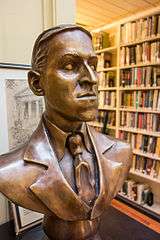
Bust of HP Lovecraft, installed 2013
-
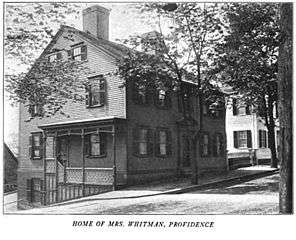
Whitman house Providence
-
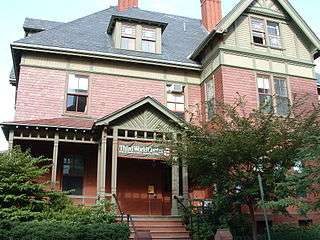
The Brown Center for Students of Color
-
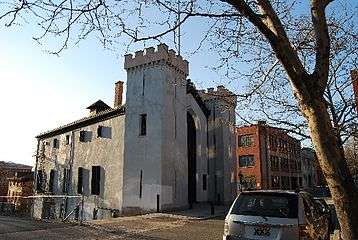
Benefit St Arsenal
-
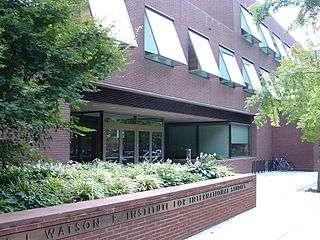
Brown University-Watson Institute
-
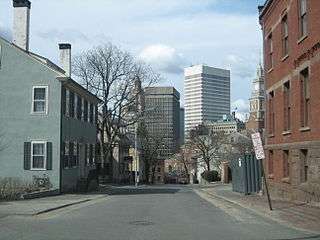
The Providence skyline from College Hill
-

RISD Museum of Art Chace Center entrance
-

Entrance on Benefit Street
Notable people
References
- 1 2 Great Places in America | American Planning Association
- ↑ Providence Preservation Society
- ↑ "The sound of 3,355 pipes - Today at Brown". Brown University. Retrieved October 8, 2014.
- ↑ http://www.gaspee.org/ONBG.html
- ↑ Providence, Rhode Island | Neighborhood Services | College Hill
- ↑ ward1.jpg
- ↑ ward2.jpg
- 1 2 College Hill
- ↑ Hope High School Arts Community
- ↑ Brown University Bookstore
- ↑ Avon Cinema
- ↑ Providence Preservation Society
- ↑ First Baptist Church in America
- ↑ Welcome to College Hill, the historic heart of Providence
- ↑ Benefit Street, an enduring elegance | Providence | Rhode Island news | projo.com | The Providence Journal
- ↑ Rhode Island State Police: History
Further reading
 College Hill travel guide from Wikivoyage
College Hill travel guide from Wikivoyage- Providence Neighborhood Profiles, College Hill
Coordinates: 41°50′N 71°24′W / 41.83°N 71.4°W